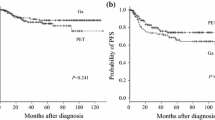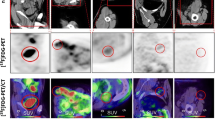Abstract.
The clinical impact of gallium-67 scintigraphy before and after therapy for lymphoma remains controversial. The aims of this study were: (1) to compare the staging of lymphoma by 67Ga scintigraphy only with staging by clinical examination and conventional imaging (CI), and (2) to analyse the clinical relevance of both 67Ga imaging and CI after treatment. From March 1995 to November 1998, 86 67Ga scintigraphy studies were performed in 62 patients with Hodgkin’s disease (n=52) or non-Hodgkin’s lymphoma (n=10). 67Ga scintigraphy was performed at diagnosis (n=44) or after therapy (n=42) using 185–220 MBq 67Ga citrate and planar and single-photon emission tomography (SPET) studies. Treatment comprised radiotherapy, chemotherapy or combined modalities. CI included plain chest radiography, computed tomography (CT) of the chest and abdomen/pelvis, ultrasound of the abdomen, lymphography, bone marrow biopsy and, when necessary, magnetic resonance imaging (MRI) and bone scintigraphy. For individual suspected sites of disease before treatment, complete agreement between clinical examination and CI on the one hand and 67Ga scintigraphy on the other hand was observed in 25/44 patients (57%; 95% confidence interval 41%–72%). Clinical examination and CI showed more sites than did 67Ga scintigraphy in 12/44 patients (27%) and 67Ga imaging demonstrated more sites than CI in 6/44 patients (11%). The clinical stage of the disease as assessed using 67Ga scintigraphy only was in agreement with that using all diagnostic procedures in 34/44 patients (77%; 95% confidence interval 62%–89%). Compared with CI staging, 67Ga scintigraphy downstaged seven patients (16%) and upstaged three (7%). 67Ga scintigraphy downstaged mainly because of the limited value of the technique below the diaphragm and upstaged owing to the good sensitivity in the lung. After therapy, both CI and 67Ga scintigraphy were normal in 11 patients. All but one of these patients were in complete remission after a median follow-up of 31 months. In contrast, radiological residual mass was observed in 31/42 patients. 67Ga imaging was normal in 22/31 (71%); 17 of these 22 patients, including nine with a large residual mass (≥2 cm), were in complete remission after a median follow-up of 32 months, while four suffered relapses 8–45 months later. The cause of death remained unknown in one patient. 67Ga scintigraphy showed abnormal uptake in 9 of the 31 patients with a large residual mass. Active disease was demonstrated in eight patients and one patient was in complete remission 30 months thereafter. Our data show that 67Ga imaging cannot replace CI in initial staging but can demonstrate additional individual sites of disease in more than 10% of patients and can lead to clinical upstaging with potential prognostic and therapeutic consequences. After therapy, 67Ga scintigraphy has a clinical impact when radiological abnormalities persist because it can either avoid unnecessary complementary treatment or confirm the need to change treatment modalities.
Similar content being viewed by others
Author information
Authors and Affiliations
Additional information
Received 5 July and in revised form 9 September 1999
Rights and permissions
About this article
Cite this article
Delcambre, C., Reman, O., Henry-Amar, M. et al. Clinical relevance of gallium-67 scintigraphy in lymphoma before and after therapy. Eur J Nucl Med 27, 176–184 (2000). https://doi.org/10.1007/s002590050024
Issue Date:
DOI: https://doi.org/10.1007/s002590050024




